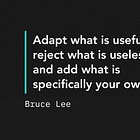The Extremes Inform the Mean
The power of exploring the fringes to unleash creative progress and innovation
Hello! I'm Pat, your guide to the business of creativity and innovation. New here? Join our supportive community to fuel your creative journey!

"What we really need to do, to design, is look at the extremes.
The weakest, or the person with arthritis, or the athlete, or the strongest, the fastest person, because if we understand what the extremes are, the middle will take care of itself.
In other words, the extremes inform the mean, but not vice versa."
– Tim Ferriss (The 4-Hour Chef)
Tim Ferriss experiments relentlessly.
In pursuit of knowledge and innovation, he pushes further into the extremes than most people are willing to go. This exploration allows him to surface insights from the fringes that might benefit a broader audience. While Tim has pulled on this thread in many disciplines (some riskier than others), I want to consider it today in the context of my creative work.
Tim’s key insight in the featured quote is how the extremes and mean relate to each other. Exploring the extremes is necessary for surfacing ideas that can transform the status quo. As I’ve explored previously with concepts like the MAYA rule and Overton Window, progress requires finding balance in iterative cycles of shake-up and settling.
Let’s explore how this manifested in my personal and work life.
Personal
The cycle of creative inspiration and stagnation never ends.
For me, it tends to look like this:
I discover a new idea, style, or format that excites me
I drill it repeatedly, riding the wave for as long as possible
The repetition eventually stagnates my creativity and I start to feel stuck
The start and end of this cycle always center around the need for a new stimulus. What begins as new, fresh, and fringe eventually becomes my new average. That average might still be quality but over time it stagnates creatively. To break away from this new status quo I must explore again.
This is where the extremes come into play.
Exploring the extremes can be psychologically taxing. They’re far outside your comfort zone. While pushing past this zone is scary, I’ve learned to reassure myself that it’s only temporary. The point is not to stay at the extremes forever. It’s to venture there long enough to uncover something and come back with a breakthrough. It’s to establish the positive feedback loop of swimming out into the deep end, returning to safety, and iterating based on what I learned.
This process has been critical to my creative growth in every discipline I’ve tried (design, programming, writing, music, improv, and more).
Work
Have you heard the adage “Nobody ever got fired for buying IBM?” It pokes fun at the power of the status quo in business and hints at the impact of risk aversion. It’s a tongue-in-cheek saying that represents my corporate experience pretty well.
Most employees optimize to keep their jobs. And most businesses don’t do much to help employees calm their survival instincts.
In that context, exploring extremes feels risky and gets avoided.
In isolation, it’s hard to argue with a safe bet. However, the compounding effect of thousands of safe bets leads to stagnation. When companies finally get desperate to escape the sea of sameness they created, they often overcompensate. Their routine risk aversion ironically leads to taking a big, poorly informed risk.
Instead of going through this painful process, companies can foster a culture of experimentation that makes space for exploring risks with asymmetric upside.
In design, you might set up a regular time for divergent exploration.
In development, you might set up “sandbox” environments to push the boundaries of your system without fear.
No matter the industry, creating standard spaces to explore extremes makes an impact. By making it a regular practice, you help the business make informed progress rather than get swept away by the inertia of safe bets.
5 Ways to Explore the Extremes With Control
Change the Environment: Changing your environment is a simple but powerful way to reshape your thinking. At a minimum, that might look like leaving your comfy home office for a work session. A next level might look like musician Bon Iver, spending a winter away in an isolated cabin to write new music. At a maximum, maybe it looks like traveling the world for an extended period (whether on your own or with a program like Remote Year). It doesn’t have to feel extreme to yield good results. Any step away from your status quo can help.
Force Constraints: Constraints come in all shapes and sizes. There are endless options you might use to jog your creativity. Some examples include: restricting the time you have to create, limiting the number of tools at your disposal, or creating an extreme minimalist or maximalist remix of your current work. Constraints might not solve your problem, but they simulate extremes that often surface useful results.
Design a “Concept Car”: The auto industry uses the idea of the concept car to drive its designs forward. Concept cars showcase the fringes of tech and design that aren’t yet ready to hit the production line. They aren’t meant to go to the consumer as-is but rather to help guide the evolution of advances from year to year. While it’s a standard automotive practice, it’s just as useful for other businesses.
Run a Hackathon or Design Sprint: Hackathons and design sprints combine aspects of environment change, forced constraints, and concept cars to promote out-of-the-box thinking that teams wouldn’t normally have space to explore. This can lead to surprising innovations that can be refined and channeled back to the main product line.
Encourage Vulnerability: Vulnerability is scary for humans. Our default mode is to limit it at all costs. It’s a self-preservation instinct that was good at saving us from sabertooth tigers but is less helpful for making good creative work. Encouraging vulnerability can feel like a hard departure from the social status quo. But it’s a powerful extreme that results in the most personal and loved creative work.
Final Thoughts
Tim Ferriss challenges us to explore beyond our comfort zones, uncovering innovation in the uncharted.
This journey can feel risky but it’s necessary for real breakthroughs. It's about exploring the unknown and using the findings to chart a path forward for ourselves and others. It's not novelty for novelty's sake but a strategy for creative progress.
Let’s elevate the ordinary with the extraordinary.
Let's be relentless explorers.
Until next time,
Pat
Conversation Starter
What techniques have you tried to explore the extremes constructively?
Community Poll
If you got a little value from this post, consider subscribing or sharing. Follow me on LinkedIn and X/Twitter for daily posts.





